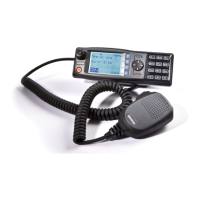In most systems, it is important to wait a short time between pressing the PTT switch
and commencing to speak. This ensures that the path is properly established and
avoids lost or distorted speech.
Use the correct on-air protocol and keep transmissions short. Release the PTT switch
as soon as the message is finished.
The talk group for a transmission is usually associated with a channel selection. A talk
group will address all others that have the same TGID selected.
Notes:
1. A Transmit Limit Timer may be setup that limits a continuous transmission on
a channel. The last 10 seconds before the timer expires may be accompanied by
warning beeps.
2. A channel may also be programmed as “Receive-only”, or “Transmit Inhibit”
which disallows PTT while the radio is receiving a signal. A continuous tone
will be heard if PTT is disallowed.
3. In analogue mode, the radio may be programmed to send a Selcall (ANI) when
the PTT is pressed or released. This may introduce a short delay before the
microphone is enabled or after PTT is released.
When transmitting a private (individual) call, the individual call icon will be displayed.
When transmitting a group call, the group call icon will be displayed.
A call can also be made as follows:
1. Using the Contacts or Call Log menus:
i. Go to the ‘Contact’ or ‘Call Log’ menus.
ii. Use the ▴ and ▾ keys to select the contact you wish to call.
iii. Press the PTT key to transmit the call.
2. By manually dialling the number.
i. Use the keypad to enter the subscriber UID, TGID or PSTN number required.
ii. Press the PTT key to transmit the call.
Receive a Call
The Speaker Icon will be displayed when a valid signal is being received and audio will
be heard at the Loudspeaker.
An outlined speaker icon will be shown when a signal is being received that is not
addressing this radio and hence, is not audible. For instance, another user group may
be having a conversation on another talk group when receiving in Selective Mute.
Document Number: TNM-U-E-0145 Issue: 1.0 Page 13

